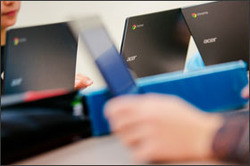Schools Buying Ed-Tech Tools, Then Failing to Use Them
At eduCanon we are looking to better understand how instructional tools work in the classroom, so we wanted to share some research from Karl Rectanus, founder of LearnTrials. Note: eduCanon was not one of the tools tested in this study.
Guest post by Karl Rectanus
The United States K-12 market spends upwards of $8 billion on classroom software and systems. But how much are those learning products actually used? Schools are now starting to focus on usage of these digital tools, and what they’re finding has implications for instructional practices, school operations, and budget decisions.
Modern tools are helping schools to analyze and manage their ed-tech, which has implications from classroom to boardroom. A recent research brief and infographic, published by Daniel Stanhope, myself, and the team at Lea(R)n, shares the strikingly consistent usage patterns of core instructional products.
The early findings are based on 49 schools’ use of six well-established math and literacy products, each with licensing fees ranging from $15 to about $100 per student, across about 17,000 students:
- Approximately 65 percent of paid student licenses were never activated or met no milestones. (37 percent never used, 28 percent met no milestones)
- Only 5 percent of product licenses were used enough to fully meet goals set by the product companies and districts. For an average district of 3,700 students paying $25 per student, that translates to only $4,625 of over $92,000 in student licenses fully utilized.
- The research showed local implementation and other variables impacted relationships between product use and student achievement. Sometimes there was a linear correlation, meaning more usage leads to greater learning. Other times, a certain dosage is required before students exhibit greater achievement. There were even cases in which excessive use had negative impact on students.

The report does not suggest classroom technology is useless; just the opposite, it suggests that ed-tech used appropriately may have significant impact on achievement, but modern ed-tech management is needed to understand and improve implementation and budgets in local contexts.
Certainly, the research suggests that the clarity these schools are gaining inside and across their classrooms on how learning tools are being used can improve spending, implementation, and professional development. For example, school districts with effective ed-tech management systems can personalize learning at scale by targeting specific tools more effectively and use contracts that only purchase what is needed, rather than the standard one-size-fits-all method for product purchases. Additionally, rapid insights about which student groups are gaining the most, how implementation is perceived, educator insights on alignment with standards, or the findings of similar populations can be used to focus budget dollars and get a better handle on the instructional and operational returns on those investments.
For more information follow @LearnTrials on Twitter.

One thought on “Schools Buying Ed-Tech Tools, Then Failing to Use Them”